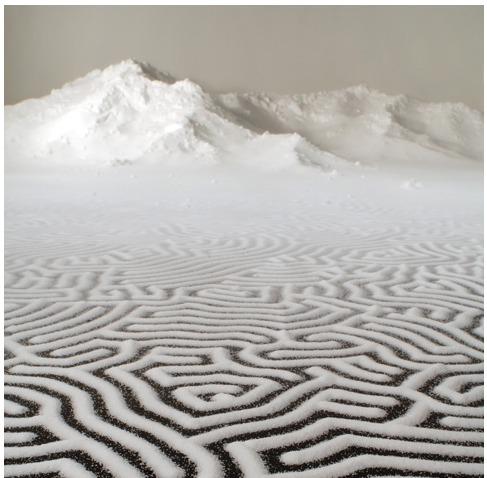Friday Inspiration: Motoi Yamamoto

It’s been a while since I’ve posted a ” Friday Inspiration” but I have one for this week. It absolutely defines the word inspiration.
Take a look at an incredible art installation by Motoi Yamamoto using nothing but table salt.
His work is beautiful and takes so much time to create. I often say that I love art with intricate detail and when it takes patience to create. I think for me it means that there is thought put into each piece, each detail and I love thinking about how the artist’s mind may be wandering through the process. I wonder what thoughts he’s having. Where does his mind drift in the space of creating these pieces. I think and hope that he is constantly bringing his body, mind and spirit into balance. That through the creation of something so fleeting there is a long-term and permanent effect happening to not only the artist but to the people who experience the art.
He began creating this body of work after his sister died at an early age from brain cancer. He states on his website, “The mainspring of my work is derived from the death of my sister from brain cancer at the age of 24 in the winter of 1994. Since then, I have had the dilemma, in grief and surprise, of thinking about what I had and lost. I started making art works that reflected such feelings and continue it as if I were writing a diary. Many of my works take the form of labyrinths with complicated patterns, ruined and abandoned staircases or too narrow life-size tunnels, and all these works are made with salt. A common perception towards them is “nearly reachable, yet not quite” or “nearly conceivable, yet not quite”. Memories seem to change and vanish as time goes by. However, what I sought for was the way in which I could touch a precious moment in my memories which cannot be attainable through pictures or writings.“
I love that Motoi is using salt as his art form. In the Japanese culture salt is used as a purification tool. In some rituals it is used to remove all “spiritual dirt” from the individual. It is also used to cleanse and purify an area. You can read more about that HERE on another blog I stumbled upon.
Here is what Motoi says about his using salt, “Salt seems to possess a close relation with human life beyond time and space. Moreover, especially in Japan, it is indispensable in the death culture. After my sister’s death, what I began to do in order to accept this reality was examine how death was dealt with in the present social realm. I posed several related themes for myself such as brain death or terminal medical care and picked related materials accordingly. I then came to choose salt as a material for my work. This was when I started to focus on death customs in Japan. In the beginning, I was interested in the fact that salt is used in funerals or in its subtle transparency. But gradually I came to a point where the salt in my work might have been a part of some creature and supported their lives. Now I believe that salt enfolds the メmemory of livesモ. I have thus had a special feeling since I started using it as a material.”
To think that the salt used in these art pieces is just swept up at the end of the exhibit by the people who are there and returned to the sea is just incredible. It forms a circle. I would LOVE to be one of those people, wouldn’t you? To participate at the end of the show by returning the salt to the sea. To help in the creation of the completion of the cycle. It would be such an honor. I’m going to keep my eyes out for one of his exhibits to come to a local gallery in hopes that I too can participate someday.
Here is a quote from his website…“The form as the work disappears. However, this salt dissolves in seawater and will support the life of various creatures. Possibly the opportunity when we eat it may come. Of course it is the best joy for me if it can meet again as material of the works.”
Enjoy…












